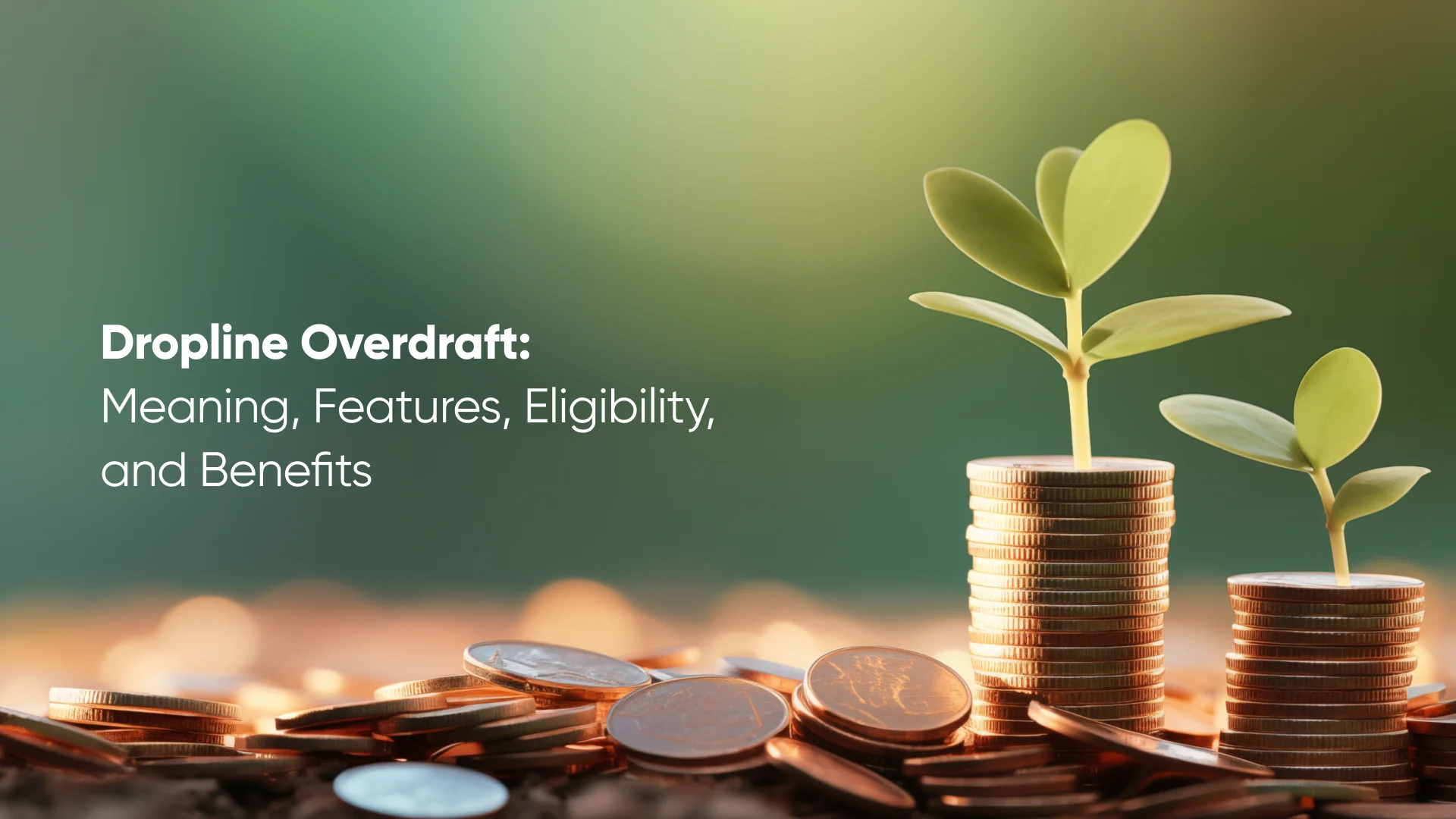Ever been in a cash crunch where you don’t really need a big loan, but still need something to tide you over? That’s where a dropline overdraft steps in. Think of it as your financial cushion. It helps you give that extra financial push, without the paperwork drama of a traditional loan.
In this blog, we’ll understand what a dropline overdraft is, who it’s for, and why it might just be your smartest backup plan.
Table of Contents
ToggleWhat is a Dropline Overdraft?
A dropline overdraft is a type of credit facility that works a bit like a loan and a credit card combined. The bank gives you access to a fixed credit limit, however the limit keeps reducing every month.
Imagine it like this: You start with ₹5 lakhs today, but every month, your available limit drops a little, even if you don’t use the money. So after 12 months, you might only be able to borrow ₹4 lakhs, and so on, until it eventually reaches zero by the end of the term.
The good part?
- You don’t have to take the entire amount at once.
- You only pay interest on the amount you actually use, not the full limit.
- You can repay and re-use within the available (shrinking) limit.
It’s a great option if you’re running a business, managing unpredictable cash flow, or need a flexible borrowing option without going through loan approvals again and again. Just keep in mind: the longer you wait to use it, the lesser the limit becomes.
How Does Dropline Overdraft Work?
A dropline overdraft is like a loan you can dip into when needed, but with some structure. Here’s how it works in simple terms:
- The bank sanctions a credit limit (say ₹5 lakhs) for a fixed tenure (say 3 years).
- Each month, your available credit limit reduces. This is the “dropline.”
- You only pay interest on the amount you use, not the full limit.
- You can repay and reuse the amount within your shrinking limit during the tenure.
- It gives you the flexibility of an overdraft but adds discipline with a reducing limit.
Let’s say you get a dropline overdraft approved for ₹5 lakhs for a period of 3 years. Here’s what happens next:
- Fixed Credit Limit, Fixed Tenure: The bank sets a total credit limit (like ₹5 lakhs) and a time frame (like 3 years). This means you can borrow up to ₹5 lakhs during this period.
- Your Limit Reduces Every Month: Unlike regular overdrafts where the limit stays the same, here your available limit reduces every month. For example, by the end of year one, your limit might drop to ₹3.3 lakhs instead of ₹5 lakhs.
- Interest Only on What You Use: You don’t pay interest on the entire ₹5 lakhs. You only pay interest on the amount you’ve used. So, if you used ₹1 lakh, you’ll only be charged interest on that, not the full limit.
- You Can Repay and Reuse (Within the Dropping Limit): You’re free to repay early and borrow again, as long as it’s within your current available limit. For example, if your limit today is ₹4 lakhs and you’ve repaid a past amount, you can borrow again up to ₹4 lakhs.
- It’s Flexible Yet Structured: It works like an overdraft by offering flexibility to borrow as needed. But the ‘reducing limit’ brings in a sense of financial discipline, ensuring you gradually wind down your borrowing.
Also Read: Personal Loan Overdraft Facility Explained: Key Information and Benefits
Key Features of Dropline Overdraft
A dropline overdraft gives you easy access to money whenever you need it, like a credit limit you can use anytime. The differentiating factor is your limit reduces a little every month until the end of the tenure. It’s a good option for salaried people who want short-term funds without paying high interest or fixed EMIs.
1. Reducing Limit Over Time
Unlike a regular overdraft, a dropline overdraft comes with a pre-set tenure. The total limit reduces every month till it reaches zero by the end of the term. So, for instance, if you take a ₹1,20,000 limit for 12 months, your available limit will reduce by ₹10,000 every month.
It brings more financial discipline. You’ll know exactly how much you can access each month, which helps you plan repayments better.
2. Pay Interest Only on What You Use
You’re not charged interest on the total sanctioned limit. You only pay interest on the actual amount you withdraw, and only for the number of days it’s used.
It’s a cost-effective solution for short-term or unexpected needs like a medical emergency or repairing a bike because you’re not paying extra on unutilized money.
3. Flexible Withdrawals and Repayments
You can withdraw any amount within your available limit, any number of times. And you can repay whenever you want within the tenure.
This flexibility works great if your income or expenses fluctuate, or if you get variable bonuses/incentives.
4. No Collateral for Salaried Borrowers
Most salaried professionals can get this facility without pledging any assets like gold, FD, or property. Approval is usually based on salary slips and bank statements.
It is a great unsecured option if you don’t have collateral but need funds quickly.
5. Tenure-Based Structure (12 to 60 Months)
You can choose a repayment tenure between 1 to 5 years. The longer the tenure, the slower your limit reduces and gives you more time to use the funds.
You can align it with your cash flow and choose a plan that doesn’t put pressure on your monthly budget.
6. Digital and Paperless Access
Many leading banks and NBFCs offer the entire process online, from application to approval and withdrawals. Some even allow you to manage your overdraft via mobile apps.
You get quick, hassle-free access to funds from the comfort of your home or office.
Benefits of Dropline Overdraft Facility
Why do many people choose a dropline overdraft instead of a regular loan? Here are the key reasons:
Saves Money on Interest
You only pay interest on the amount you use, not the full limit. That means lower interest costs compared to EMIs on full loans.
Use Anytime After Approval
Once your overdraft is approved, you don’t need to apply again. Just withdraw money as and when you need it.
Reuse Within the Limit
You can repay and borrow again within your available limit during the tenure. It works like a reusable credit buffer.
Helps You Stay in Control
As the limit reduces every month, it prevents overspending and helps you repay on time.
Tax Savings for Business Use
If you’re using the funds for business, the interest paid might be eligible for tax deductions.
Difference Between Dropline Overdraft vs Regular Overdraft
Feature | Dropline Overdraft | Regular Overdraft |
Credit Limit | The credit limit reduces every month in equal parts until it reaches zero. | The limit is usually fixed throughout and doesn’t change unless reviewed. |
Tenure | Comes with a fixed term, typically between 12 to 60 months. | No fixed end date. It is renewed periodically (e.g. yearly) by the lender. |
Interest | Charged only on the used amount, not the entire limit. | The same interest is charged only on the amount used, not the total sanctioned limit. |
Repayment Structure | Your available limit reduces every month, so you’re pushed to repay steadily. | No such cap. You can repay whenever you like within the total sanctioned limit. |
Use Case | Best for planned or recurring needs like education, home renovation, etc. | Useful for random cash flow gaps, sudden expenses, or temporary shortfalls. |
Best For | Salaried or self-employed people with clear goals and repayment capacity. | Business owners, freelancers, or individuals who need funds for uncertain durations. |
Who Can Apply for a Dropline Overdraft?
A dropline overdraft is best suited for people who need flexible access to funds but also prefer some repayment structure. Here’s who can benefit most from this facility:
Salaried Professionals
If you have a stable job, especially in the mid to high income bracket, a dropline overdraft can act as a ready cushion for planned expenses like vacations, education fees, or home improvements. Since the limit reduces over time, it’s perfect for those who prefer structured repayments over long EMIs.
Self-Employed Individuals & Freelancers
Working on projects or receiving irregular income? This facility offers the freedom to borrow when needed and repay as money comes in. The monthly reducing limit adds just the right amount of repayment discipline.
Small Business Owners
Running a small business means cash flow can be unpredictable. A dropline overdraft can help you manage working capital, pay vendors, or cover temporary shortfalls without applying for a new loan every time.
Anyone with Predictable Income Flow
If you earn regularly, through rent, side gigs, or commissions, and want a flexible borrowing option that doesn’t feel like a rigid loan, dropline overdraft can be a smart choice. You borrow only what you need, repay at your pace (within the tenure), and avoid paying interest on unused amounts.
Eligibility Criteria for Dropline Overdraft
Age: 21–60 years
You must be at least 21 and not older than 60 by the end of the overdraft term.
Income: ₹50,000/month or more
Most lenders require a stable monthly income, starting from ₹50,000 and varies as per lender.
Employment: Salaried or self-employed
You should have a steady income with valid proof like salary slips, bank statements, or ITR.
Credit Score: 700+ preferred
A higher score improves your chances of approval, better limits, and lower interest rates.
Documents Required for Dropline Overdraft
To make the process smooth, keep these documents ready. Most lenders now accept digital copies for faster approvals.
PAN Card
It is used to verify your identity and financial history. It is mandatory for any credit-related application.
Aadhaar Card (for KYC)
It helps with quick e-KYC verification. Ensure your Aadhaar is linked to your mobile number for OTP-based authentication.
Salary Slips or Bank Statements (Last 3–6 Months)
For salaried applicants, salary slips show income consistency. Bank statements help verify regular cash flow and employer details.
Business Proof (for Self-Employed)
This includes documents like GST registration, ITR, or business registration certificate to confirm stable income and business legitimacy.
Photograph & E-signature
For digital applications, you may need to upload a passport-size photo and provide an electronic signature for paperless processing.
Interest Rate and Repayment Structure for Dropline Overdraft
Understanding how interest and repayments work is key to using a dropline overdraft smartly. Here’s how it works:
Interest Rates: 10% to 18% Per Annum
The interest rate depends on your credit score, income stability, and lender policies. Salaried individuals with a good repayment history may get lower rates, while self-employed or new borrowers may be charged on the higher side. Always compare offers before choosing.
Repayment Flexibility
There are no fixed EMIs unless you opt for them. You repay the amount you’ve used anytime during the loan tenure, be it in full or in parts. Meanwhile, your overall credit limit keeps reducing monthly, encouraging gradual repayment.
EMI Conversion Option
Some banks and fintech platforms offer the option to convert the used overdraft amount into EMIs. This is useful if you’ve used a large chunk and want to manage repayments in a more structured way.
Only Pay for Utilized Amount
One of the biggest advantages of dropline overdraft is you only pay interest when you use the funds. If you don’t withdraw any amount, you need not pay even maintenance or hidden charges.
How to Apply for a Dropline Overdraft Facility
Need extra funds but don’t want the hassle of a full loan? A dropline overdraft gives you flexible access to money. And you only pay interest on what you use. Here’s how to apply in just a few easy steps.
Step 1: Check Eligibility
Use platforms like Zype to check if you’re eligible in seconds. Just enter your basic details.
Step 2: Upload Basic Documents
Submit your PAN, Aadhaar, and income proof (salary slips or bank statements) for quick verification.
Step 3: Complete e-KYC
Verify identity with Aadhaar OTP and a selfie. No physical paperwork required.
Step 4: Get Instant Limit Approval
AI evaluates your profile and approves a limit based on your income and credit history.
Step 5: Start Using Your Limit
Withdraw funds as needed within your approved limit and the interest will apply only on what you use.
Conclusion
If you want flexible access to funds without taking a heavy loan, dropline overdraft is a smart option. It combines the freedom of overdrafts with the structure of loans, ideal for managing cash flow without paying interest on unused money.
Just make sure you understand the repayment terms and choose a trusted lender. And remember, borrow what you need, repay on time, and let your credit profile stay healthy and stress-free.
Frequently Asked Questions
You only pay interest on the amount you use, not the full limit, and the credit limit reduces over time, helping you borrow responsibly. It offers flexibility, easy access to funds, and can be reused during the tenure.
The main feature is that it allows you to withdraw more money than what is available in your account, up to a sanctioned limit.
Yes, self-employed professionals can apply, provided they have a stable income and meet the lender’s eligibility criteria.
Interest is charged only on the amount you withdraw, not the entire limit, and it’s calculated on a daily basis until the amount is repaid.
Salaried individuals, professionals, and self-employed people with a good credit score and steady income are generally eligible.
In a regular overdraft, the limit stays fixed, whereas in a dropline overdraft, the credit limit reduces every month until the end of the tenure.













